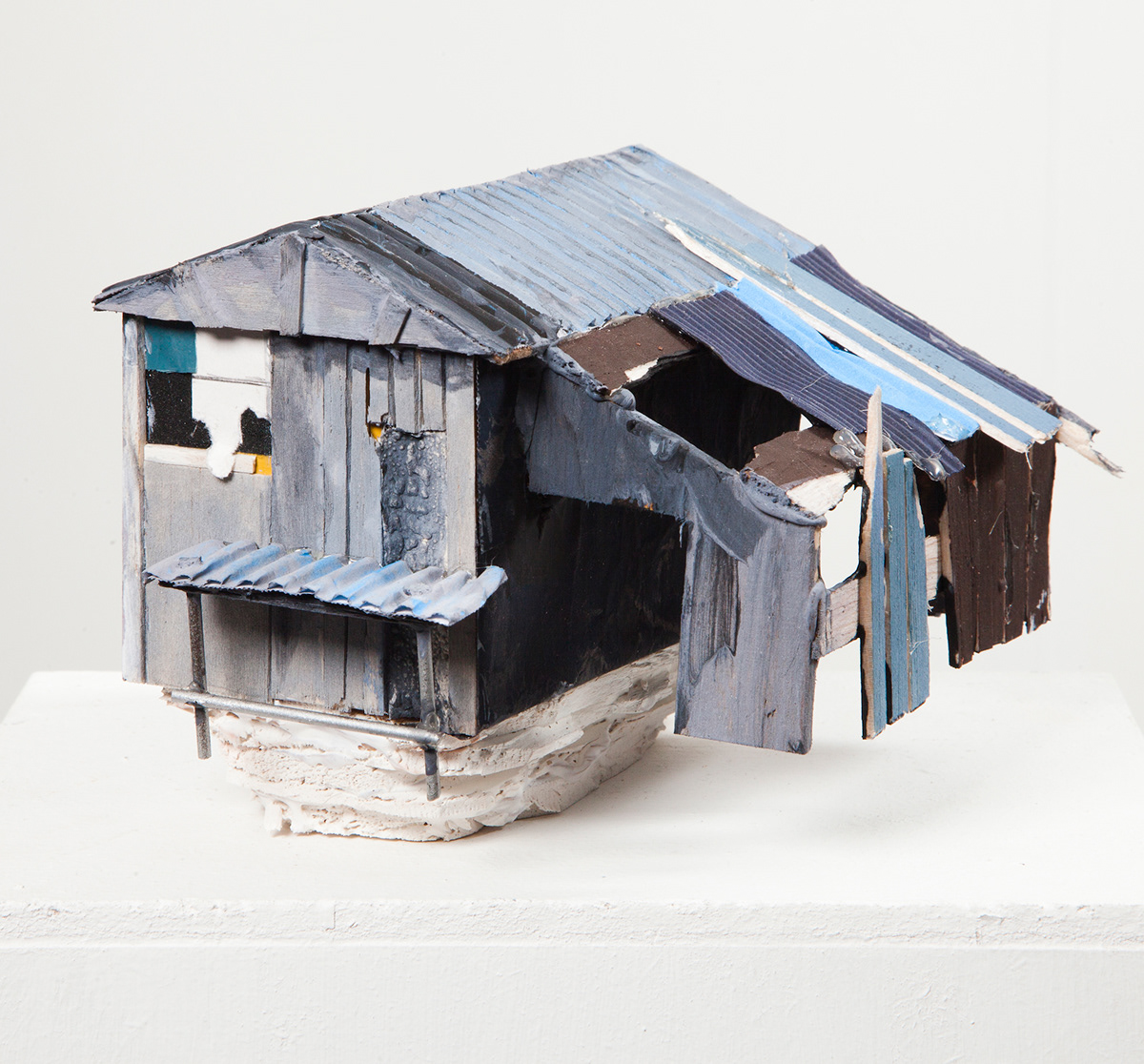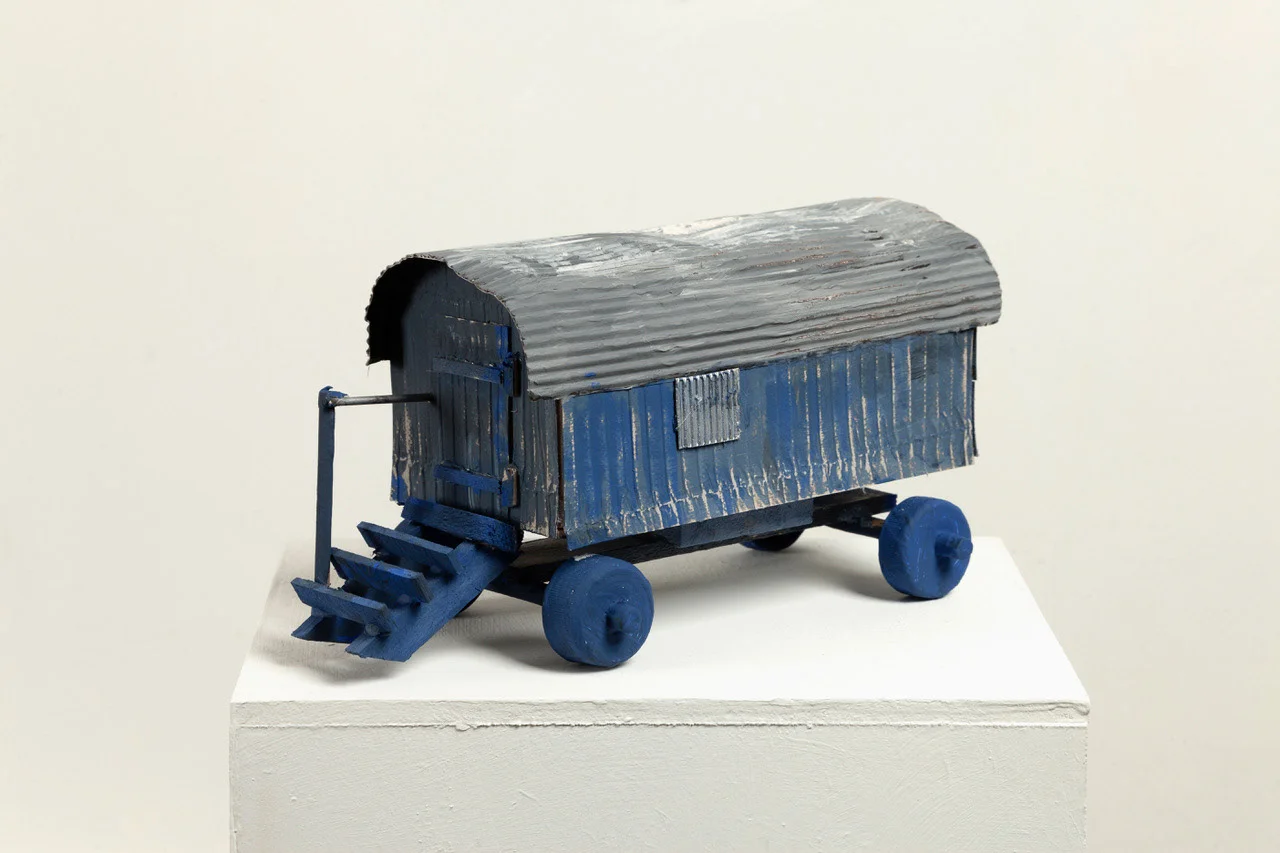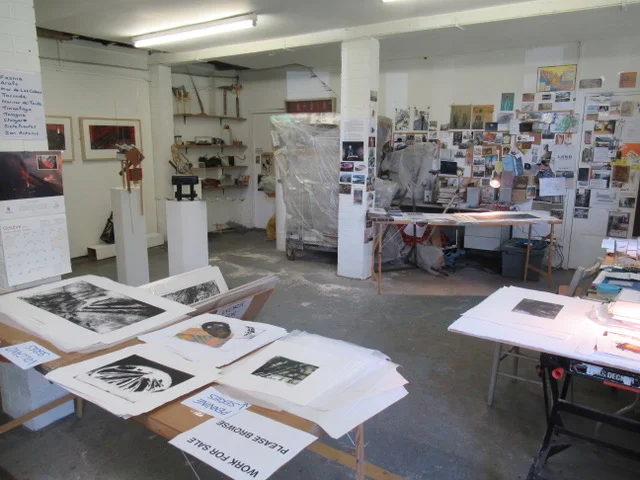Terrible Beauty and ‘Anti-Tasteful’ Aesthetics: Jill Randall – In Conversation
Sara Jaspan
Sheds of Rochdale. Shed on Stilts (2013). Mixed media. Photo by David Bennett
Jill Randall makes site-specific sculptures and installations that explore issues surrounding place, landscape, industrial heritage and the environment. Here she talks to Sara Jaspan about her miniature shed series (currently on show at Venice Biennale 2019), her creative process, and the wider themes within her practice.
Sara Jaspan: The work you’re currently presenting as part of ‘Personal Structures’ at Venice Biennale consists of a series of miniature sheds – referred to in the title of each as being variously of Bocholt, Rochdale, and the Grand Canal. Can you explain the significance of the work and locations?
Jill Randall: The small ‘sheds’ or buildings – sometimes just parts of buildings – that make up each series are faithful recreations of real structures that I’ve encountered in various locations across the UK and Europe. The Bocholt sheds, for example, were made during a residency in Bocholt, Germany in 2016. They are a highly selective sample of course (based on my own limited travels), but they do reflect the environment from where they came – its industrial past and economic present, its social, historical and cultural identity and so on. Each model is a tiny piece of place removed and represented for our scrutiny.
Sheds of the Grand Canal is a new series that I produced in the last few months especially for ‘Personal Structures’. I took a ride on the No. 1 vaporetto down the Grand Canal in Venice a couple of years ago with a camera, noticing lean-tos, solariums, and tiny architectural connections between the buildings. I’m fascinated by the artifice of Venice, with its splendid building facades that often contrast with dilapidated side walls and interiors.
I like the idea of connecting with something very local each time I show this ever-growing body of work. I constantly dream about imagined buildings, which seem so vivid I could recreate them. Maybe this will be the next series!
Sheds of Bocholt – Baumwagen (2016). Mixed media. Photo by David Bennett
SJ: How do the sheds fit within the wider context of your overall practice? What themes/questions do you tend to explore, how, and why?
My practice is largely concept driven. Though it tends to manifest itself in ways that outwardly appear quite different, the underlying interests and themes remain constant.
I’m interested in drawing connections between apparently disparate objects and places, ‘charged’ object (like saint relics), and the continued relevance and significance of objects in a digital age. I also explore the nature of time through the effect of different processes – such as burial or immersion – on materials and investigate the histories and stories behind overlooked or forgotten objects and places, seeking to reinvest them with meaning.
Alongside this, I also enjoy playing with and subverting the conventions of modernist abstract sculpture, with its emphasis on ‘truth to materials’, traditional techniques, and narrowly defined notions of value. My practice reveals an interest in the unfinished and incomplete, the broken and damaged. It celebrates an ugly and abject aesthetic, the improvised and ‘ad hoc’. I think of this sculptural concern as a kind of ‘anti-tasteful’ approach that reacts against the over-commercialisation of art. The sheds are a good example of this – taking a typically humdrum and overlooked building and turning it into something remarkable.
Sketches for the Great Abyss (2018). Steel and copper. Photo by David Bennett
SJ: It seems like you more often work with metals, found objects and recycled materials than paper. Is this correct? Why did you choose to work with paper for the shed series? What significance does paper hold within your practice?
JR: Paper is the most important material in the shed series. I’ve used everything from tissue paper, tracing paper and corrugated cardboard through to sheets of model-railway style brick and faux stone surfacing to create convincing architectural effects (distressed brickwork, a crumbling roof, fencing etc.). Paper is actually a very demanding material to work with because it’s so fragile, and so has to be painstakingly and lovingly manipulated. I like making substantial models that have a sense of gravitas out of something so light and simple. It’s a great challenge.
I spend a lot of time finding and accumulating different types of paper, and I often recycle papers from earlier pieces. I’ve recently started working some wonderful vintage wallpaper sample books containing designs from the 1930s through to the 1970s. I love how ‘of their time’ they are. Some of the models from the new Sheds of the Grand Canal series incorporate these samples, which can be found ripped and exposed on the sides of the miniature Renaissance buildings.
I do also use the other materials you mention in a lot of my practice. I’ve always enjoyed working with unlikely combinations – such as bringing something valuable like copper into dialogue with something ‘trashy’ and throwaway like cellophane. I like subverting sculptural traditions and questioning what value is. Cheap and commonplace, paper is the opposite of what sculpture is traditionally considered to be made of. I love the fact it’s so ephemeral and yet actually very robust – in the past, I’ve even used it to create drawings using mineral drippings in an old copper mine. The range of forms I can make with paper plays a vital role in my practice.
Found Drawing at Parys Mountain, the Amlwch Copper Heritage Centre, Anglesey (2007)
SJ: PAPER’s presentation within ‘Personal Structures’ explores the artist’s studio – framing it as ‘a symbolic chamber where the artist draws deep from within themselves.’ Could describe your own studio/the place where you tend to make work. What significance does it hold for you? What conditions do you need in place to work?
JR: I often describe my studio as ‘mission control’ for the different projects that I work on, which tend to take place elsewhere. When people visit, it provides a sort of snapshot of the range of things I do.
It’s a vitally important space for me; full of objects that I like, that I’ve collected over the years, that sum up my past and present as an artist and a person, that remind me what I’m doing, even when I’m not very active. These range from postcards from places I’ve visited to wax votives, model kidneys and fossil finds. I love being surrounded by these things and, collectively, their presence all adds up to create the optimum conditions for making work.
I have a great space – a large room which I have to myself with a metal/welding workshop area, lots of blank walls, and heating! It’s part of a building complex in Rossendale (outside of Manchester) that I share with artists Alan Birch and Liam Spencer.
I’ve undertaken artist residencies all over the world and had temporary studios in factories and heritage sites such as the Magnesium Elektron factory in Salford and Parys Mountain at the Amlwch Copper Heritage Centre in Anglesey, so I’m now quite used to taking my studio with me to other places (both in a psychological and literal sense). My work in ‘Personal Structures’ is a sharing of that contemplative, playful world of the studio through exposing the pieces I make within the shelter of its privacy to a wider audience. I particularly like the fact that a little bit of Rochdale and Rossendale is now being seen by around 1,500 visitors a day in the Palazzo Mora!
Jill Randall’s studio in Rossendale
SJ: Could you describe the journey of setting out on a new piece/project? Where do you draw your ideas from and how do they become manifest? Do you find making a therapeutic process?
JR: My ideas and process are part of a continuum that has built up over many years of making art, though sometimes beginning a new piece can feel like reinventing the wheel! I guess this is largely because I have a concept-based practice, so I’m usually working with my thoughts and imagination rather than directly from life. I don’t visualise a piece in advance but try to take a very intuitive approach, responding directly to the material I’m working with.
I do find the making process therapeutic but only when it’s going well. If not, it’s the worst and most frustrating thing in the world. Therapy is no good on its own; I have greater aspirations than that!
SJ: You position your work as an exploration of the relationship between contemporary art and the environment. Can you explain in what way it does this?
I’ve always liked unfamiliar and extreme environments – the ‘abused’, post-industrial landscapes of Robert Smithson’s Land Art; the peculiar and darkly beautiful volcanic terrain of the Canary Islands; the ‘terrible beauty’ of the toxic abandoned copper mine at Parys Mountain; industrial estates, power stations, chemical works, old farms, the backstreets of working towns.
I’ve undertaken artist residencies in several unusual location over the course of my career, such as abandoned mining sites and metal-processing factories in the UK, America and Mexico. A lot of my work explores both the contamination of these places and the plant and animal life that manages to survive there, creating an alternative nature and beauty. I like subverting our sense of what nature, beauty and art can be.
Print from new series in progress, made at Eureka Reef Gold Diggings, Castlemaine, Victoria, Australia (2018). Photo by David Bennett
SJ: You’re also interested in using contemporary art to offer an alternative perspective on industrial heritage. Could you expand on this for us?
JR: I’ve recently been working on a project at Geevor Tin Mine museum in Cornwall with a sociologist, challenging visitors by presenting them with quite probing artwork in a setting where they wouldn’t normally expect to find it. We’ve had some very positive reactions from people, many of whom said they wouldn’t normally visit an art gallery. I’ve always liked the Paul Klee quote: “Art does not reproduce the visible; rather, it makes visible.” My aim is to help unlock feelings of awe, wonder and contemplation in viewers in response to a particular place, rather than simply re-presenting it to them.
The idea of what constitutes heritage, and for whom, is contested territory. My work has been in the area of industrial and, specifically, mining heritage for a long time, and recent visits to Australia and Mexico have reinforced the multiple and complex social and historical questions arising from the preservation/neglect/destruction of industrial sites. I focus on what interests me as an artist but use this to quietly expose some of these issues. I think it’s vitally important that we remember and preserve this often-overlooked strand of history; it’s part of what defines who we are.
Randall’s shed series remains on display within the ‘Personal Structures’ strand of Venice Biennale until 24 November 2019.






